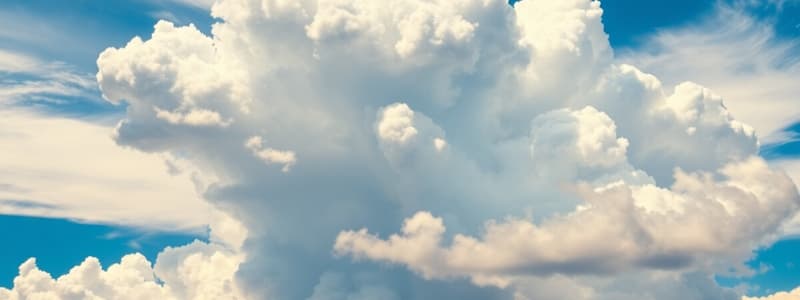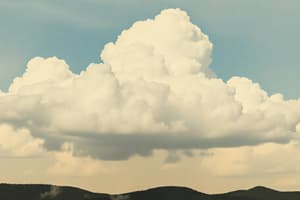Podcast
Questions and Answers
A pilot reports encountering a cloud layer at approximately 12,000 feet. Based on standard cloud classification, which category would this cloud layer most likely belong to?
A pilot reports encountering a cloud layer at approximately 12,000 feet. Based on standard cloud classification, which category would this cloud layer most likely belong to?
- Middle clouds (correct)
- Vertical clouds
- Low clouds
- High clouds
Which of the following cloud types is LEAST likely to be associated with significant precipitation?
Which of the following cloud types is LEAST likely to be associated with significant precipitation?
- Cumulonimbus
- Cumulus
- Nimbostratus
- Cirrus (correct)
A weather forecast mentions 'altocumulus clouds forming due to convection'. What atmospheric process is primarily responsible for the formation of these clouds?
A weather forecast mentions 'altocumulus clouds forming due to convection'. What atmospheric process is primarily responsible for the formation of these clouds?
- Radiational cooling of the ground at night
- Advection of warm, moist air over a cold surface
- Rising warm air that cools and condenses (correct)
- Subsidence of air in a high-pressure system
Observing a uniformly gray cloud layer that obscures the sun and covers the entire sky, which cloud type is the MOST probable?
Observing a uniformly gray cloud layer that obscures the sun and covers the entire sky, which cloud type is the MOST probable?
How do cirrostratus clouds differ MOST significantly from cirrocumulus clouds in terms of their appearance?
How do cirrostratus clouds differ MOST significantly from cirrocumulus clouds in terms of their appearance?
Which of the following conditions is essential for the initial formation of a cloud?
Which of the following conditions is essential for the initial formation of a cloud?
If you observe clouds that appear as sheets of cumulus clouds 'smeared' across the sky, which cloud type are you MOST likely seeing?
If you observe clouds that appear as sheets of cumulus clouds 'smeared' across the sky, which cloud type are you MOST likely seeing?
Which statement accurately describes the relationship between fog and stratus clouds, as indicated in the provided text?
Which statement accurately describes the relationship between fog and stratus clouds, as indicated in the provided text?
What primarily determines the shape, color, and atmospheric position of a cloud?
What primarily determines the shape, color, and atmospheric position of a cloud?
As water vapor rises in the atmosphere to form a cloud, what process directly leads to the condensation of water droplets?
As water vapor rises in the atmosphere to form a cloud, what process directly leads to the condensation of water droplets?
Clouds are classified into categories based on their altitude. Which of the following is NOT a primary altitude category for cloud classification?
Clouds are classified into categories based on their altitude. Which of the following is NOT a primary altitude category for cloud classification?
What is the approximate altitude range for medium clouds?
What is the approximate altitude range for medium clouds?
Clouds are made up of water in two different states. What are they?
Clouds are made up of water in two different states. What are they?
What happens to water on the Earth's surface before it becomes a cloud?
What happens to water on the Earth's surface before it becomes a cloud?
What is NOT a characteristic of clouds?
What is NOT a characteristic of clouds?
Flashcards
Low Clouds
Low Clouds
Clouds that occur below 7,000 feet, sometimes even on the Earth's surface.
Cumulus Clouds
Cumulus Clouds
White, puffy, irregular clouds with flat bottoms, often associated with fair weather.
Stratus Clouds
Stratus Clouds
Gray, sheet-like clouds that may produce light showers or snow.
Middle Clouds
Middle Clouds
Signup and view all the flashcards
Altocumulus Clouds
Altocumulus Clouds
Signup and view all the flashcards
High Clouds
High Clouds
Signup and view all the flashcards
Cumulonimbus Clouds
Cumulonimbus Clouds
Signup and view all the flashcards
What are clouds?
What are clouds?
Signup and view all the flashcards
What is evaporation?
What is evaporation?
Signup and view all the flashcards
What is condensation?
What is condensation?
Signup and view all the flashcards
What are atmospheric particulates?
What are atmospheric particulates?
Signup and view all the flashcards
What are low clouds?
What are low clouds?
Signup and view all the flashcards
What are medium clouds?
What are medium clouds?
Signup and view all the flashcards
What are high clouds?
What are high clouds?
Signup and view all the flashcards
How are clouds categorized?
How are clouds categorized?
Signup and view all the flashcards
Study Notes
- Clouds are collections of ice crystals and water vapor in the atmosphere.
- A cloud's structure, shape, and appearance varies based on water content and environmental factors.
- Cloud properties differ, with formation times ranging from minutes to hours.
- Cloud sizes vary and some clouds can weigh over a million pounds.
Cloud Formation
- Cloud formation begins with water evaporation from the Earth's surface into water vapor.
- Water vapor rises and cools with increased atmospheric elevation.
- Cooling causes water droplets to condense via contact with airborne particulates.
- Collections of water droplets group together, forming clouds.
- A shapes, colors, and atmospheric position identifies a cloud's type
Cloud Categories by Altitude
- Low clouds: surface to 7,000 feet
- Medium clouds: 7,000 to 17,000 feet
- High clouds: 17,000 to 35,000 feet
- Vertical clouds: span multiple atmospheric heights
Low Clouds
- Low clouds occur below 7,000 feet and can even be found on the Earth's surface.
- Fog is a low-hanging cloud.
- Types of low clouds:
- Cumulus
- Stratus
- Stratocumulus
- Cumulus clouds:
- White, irregular clouds that develop on clear days
- Uneven edges and flat bottoms
- Large cumulus clouds can produce rain and thunderstorms
- Often called "fair weather clouds" due to association with pleasant weather
- Stratus clouds:
- Grey and appear as a sheet across the sky
- May form from rising fog via warm, uplifting wind
- Thick stratus clouds can develop light showers or snow
- Stratocumulus clouds:
- Hybrid of cumulus and stratus clouds
- Look like sheets of cumulus clouds smeared across the sky
- Often grey and form when cumulus clouds split apart
Middle Clouds
- Middle clouds are found between 7,000 and 17,000 feet.
- Types of middle clouds:
- Altocumulus
- Altostratus
- Nimbostratus
- Altocumulus clouds:
- Small white or gray clouds that dot the sky
- More or less have definitive edges
- Can produce light showers and sometimes thunderstorms
- Form via convection, where rising hot air cools rapidly
- Altostratus clouds:
- Appear sheet-like without well-defined edges
- May occasionally produce rain, snow, or hail
- Nimbostratus clouds:
- Dark grey and are thick enough to hide the sun
- Cover most of the sky and create dark, dreary days
High Clouds
- High clouds are found between 17,000 and 35,000 feet.
- Types of high clouds:
- Cirrus
- Cirrocumulus
- Cirrostratus
- Cirrus clouds:
- White and composed of ice
- Found at roughly 20,000 feet
- Appear like wispy collections of hair
- Cirrocumulus clouds:
- Appear like sheets of white clouds cut into small, individual rows
- Cirrostratus clouds:
- Sheets of cloud that expand across much of the sky
- Largely transparent and may cause a halo around the sun
Vertical Clouds
- Cumulonimbus clouds:
- Tall and span across elevational boundaries
- May appear as large, boding clouds with an anvil-shaped top
- Generally form before thunderstorms
Studying That Suits You
Use AI to generate personalized quizzes and flashcards to suit your learning preferences.




